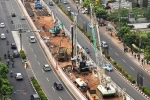Jabodebek LRT targets passengers in 310 residential and commercial areas
This article has been translated by PwC Indonesia as part of our Indonesia Infrastructure News Service. PwC Indonesia has not checked the accuracy of, and accepts no responsibility for the content.
Investor Daily - LRT Jabodebek incar penumpang di 310 kawasan Permukiman dan komersial
5 July 2023
By: Amrozi Amenan
Jakarta - Jabodebek Light Rail Transit (LRT) is targeting passengers in 310 residential and commercial areas that are located less than 5 km from its stations. Hence, the modern rail-based mass transportation must be integrated with feeders when it operates.
“The success of Jabodebek LRT will be determined by the availability of feeders from several residential areas that are connected to the stations,” MTI Territorial Empowerment and Strengthening Deputy Chairperson Djoko Setijowarno said on Tuesday (4/7/2023).
According to Djoko, the potential of the 310 residential and commercial areas is based on Study on the Potential of the Public Transportation Network and Mode Integration around Jabodebek LRT Corridor in 2020 that was conducted by PT Kereta Api Indonesia (KAI).
“Accessibility from the 310 residential and commercial areas must be provided to facilitate Jabodebek LRT passengers,” he stated.
Djoko mentioned the locations of the 310 residential and commercial areas. Along the Cawang-Harjamukti route (14.89 km) that has four stations, there are 38 residential and commercial areas around Harjamukti Station, 20 residential and commercial areas around Ciracas Station, 18 residential and commercial areas around Kampung Rambutan Station, and 11 residential and commercial areas around TMII Station.
Along the Cawang-Jatimulya route (11.05 km), there are seven stations. There are 14 residential and commercial areas around CIliwung Station, 14 residential and commercial areas around Cikoko Station, 6 residential and commercial areas around Pancoran Station, 6 residential and commercial areas around Kuningan Station, 14 residential and commercial areas around Rasuna Said Station, 14 residential and commercial areas around Setiabudi Station, and 13 residential and commercial areas around Dukuh Atas Station.
Then, along the Cawang-Dukuh Atas route (18.49 km), there are seven stations. There are 15 residential and commercial areas around Cawang Station, 10 residential and commercial areas around Halim Station, 19 residential and commercial areas around Jatibening Station, 39 residential and commercial areas around Cikunir 1 LRT Station, 19 residential and commercial areas around Cikunir 2 Station, 16 residential and commercial areas around Bekasi Barat Station, and 23 residential and commercial areas around Jatimulya Station.
He continued that currently there were around 203 routes that serve the stations. In detail, there are 11 routes that serve Harjamukti Station, 5 routes that serve Ciracas Station, 25 routes that serve Kampung Rambutan Station, 15 routes that serve TMII Station, 18 routes that serve Cawang Station, 10 routes that serve Ciliwung Station, 9 routes that serve Cikoko Station, 12 routes that serve Pancoran Station, 9 routes that serve Kuningan Station, 9 routes that serve Rasuna Said Station, 9 routes that serve Setiabudi Station, 8 routes that serve Dukuh Atas Station, 19 rutes that serve Halim Station, 6 routes that serve Jatibening Station, 5 routes that serve Cikunir 1 Station, 4 routes that serve Cikunir Station, 15 routes that serve Bekasi Baru Station, and 14 routes that serve Jatimulya Station.
“There are many modes of transportation that can be used to go to Jabodebk LRT stations. Private vehicles that are motorised and unmotorised are the easiest to use, but they lack interest. Public transportation is the most popular as they will reduce the number of vehicles parked at the stations. The average size of the parking lots at Jabodebek LRT stations is not as large as the parking lots at Greater Jakarta KRL (Commuter Line) stations” Djoko said.
According to him, the readiness of the regional governments in Bogor, Depok, Tangerang, and Bekasi is required to provide several routes to go to the nearest station. Meanwhile, several stations in Jakarta have been connected to the public transportation network that has operated first.
Integrated tariff
Ideally, Djoko said that all residential areas in Bogor, Depok, Tangerang, and Bekasi must have a public transportation service to go to the nearest Jabodebek LRT station. To reduce the transportation cost, the tariffs of the modes of transportation must be integrated. If the regional governments in Bogor, Depok, and Bekasi cannot prepare the feeders, Greater Jakarta Transportation Agency (BPTJ) can ask for assistance from PT Transjakarta or private bus companies to operate buses from several residential areas in Bogor, Depok, and Bekasi to go to the nearest Jabodebek LRT station.
“As a public transportation, the service of Jabodebek LRT must be integrated from upstream to downstream from the first mile to the last mile,” Djoko said.
He affirmed that Jabodebek LRT stations had the potential to integrate modes of transportation to support Jabodebek LRT.
“The integration must be well-defined to bring the people and the public transportation closer,” he added.
Besides that, according to Djoko, several physical integrations have been approved by BPJT, including the integrated facilities at LRT-HSR Integrated Station in Halim (PT KCIC), Revo-Bekasi Barat Jabodebek LRT Station Skybridge (PT Kilap Propertindo), the skybridge from MTH 27 Office Suite of PT Adhi Commuter Properti to Ciliwung Jabodebek LRT Station, and the skybridge from PT Kresna Inti Utama’s apartment/parking building to Bekasi Barat Jabodebek LRT Station. Besides that, there are also the skybridge from Cikunir 1 Jabodebek LRT Station (PT Urban Suite), the integrated multiuse bridge from Dukuh Atas Jabodebek LRT Station to Sudirman KCI Station, integrated intermodal supporting facilities at Cikunir 1 Jabodebek LRT Station (Bekasi Mayor), Jabodebek LRT Jatimulya TOD (Transit-oriented Development), TMII TOD, and West Bekasi TOD.
Meanwhile, as the construction progress has reached 96%, PT Kereta Api Indonesia /KAI (Persero) President Director Didiek Hartantyo is targeting the soft operation of Jabodebek LRT to commence on schedule on 12 July. During the occasion, the people are invited to board and try the modern rail-based mode of transportation.
“The progress of Jabodebek LRT has reached around 96%, and the soft operation is ready to commence on 12 July 2023. The people, media, and stakeholders will be invited to board and try the trial operation of Jabodebek LRT,” KAI President Director Didiek Hartantyo said recently.
According to Didiek, several routes will be available during the soft opening, namely Harjamukti-Cawang, Jatimulya-Cawang, and Cawang-Dukuh Atas. After the soft operation in July, Jabodebek LRT is planned to be inaugurated by President Joko Widodo on 18 August 2023.
“All routes will be opened. From Harjamukti to Cawang, the headway is six minutes. From Jatimulya to Cawang, [the headway is] six minutes. Later, from Cawang to Dukuh Atas, the headway will be three minutes during peak hours,” he stated.


















